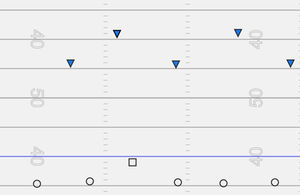Mirror the runner (Spread Run Defense Part 2 of 4)
- Coach G
- Apr 26, 2019
- 3 min read
Updated: Jan 18, 2020
Continuing my series on defensing the run out of the spread in sixman football, the second step in the process is what I term "mirroring the runner". In a separate post, I discussed the importance of "setting the edge" which allows the defense to shorten the field and take away the run outside the defensive end (DE). The next step is to insure the runner does not have the ability to cut up the field through the middle of the defense.
In Figure 1, you will see the standard sweep employed by most sixman spread teams. For this discussion we will assume the wide receiver on the edge is not cracking back on the DE. What we have is four offensive players who start in the middle of the field and four defenders. It is important to note that while Figure 1 exhibits a 4-2 alignment the concept works in a 3-2, 2-3 or 2-2 as well.

The LB on the sweep side is employed as the "mirror defender". It is his job to mirror the running back. This is to say he is to keep his shoulders parallel to the line of scrimmage (LOS) at the point where he makes contact with the lead blocker and then, with his arms extended, he takes on the lead blocker. In Figures 2a and 2b you will see the good form of keeping the lead blocker away from his body while insuring he mirrors the RB.


The drill we use to practice defensing the sweep is called the "Rabbit Drill" and we have a coach pitch the ball directly to the runner and then have the offense sweep either left or right. While in a game scenario the up-back would have to pitch the ball to the runner, we want to give the offense an advantage so as to emphasize the importance of working on our defensive positioning.
We are adamant about the role for each player in the Rabbit Drill. The defender executing the mirroring is told not to make a tackle! The point we are drilling into this players head is to focus on stopping the forward progression of the runner by engaging the blocker and remaining parallel to the LOS. If the blocker can turn him to either sideline then a crease is created which the runner can exploit.
Another common mistake is for the defender to "peek" (Figure 4). This is the act of trying to go around the blocker (on either side) to make the tackle. This is the prideful player who attempts to make a play and in the process creates a gap for the runner to exploit and effectively negating the opportunity for the unblocked player to make a tackle.

Coaching Point: We like to rep just the act of taking on the lead blocker and we have a runner and lead blocker do this by having them run between two cones. You need someone to run the ball so the defender can A. be tempted to make a tackle B. understand the spacing and C. realize first hand what can happen if he peeks.
Ultimately, we want the players to know that championship defense is teamwork with everyone doing there job. The play side DE sets the edge, the play side LB mirrors the runner and the backside DE closes the gap. The result is a funneling of the runner to a point where he has no options and we can converge to make a tackle.
------- > Closing the Gap
.png)


























Comments